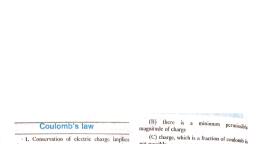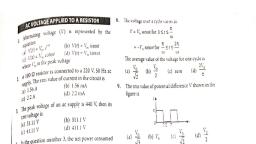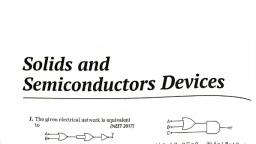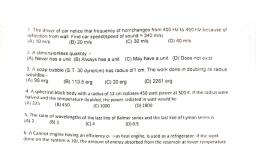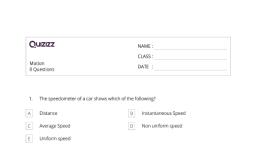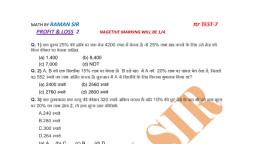Question 1 :
In a multi-electron atom, which of the following orbitals described by the three quantum numbers will have the same energy in the absence of magnetic and electric field ?<br>(i) n = 1, l = 0, m = 0 (ii) n =2, l = 0, m = 0 (iii) n = 2, l = 1, m = 1 (iv) n = 3, l = 2, m =1 (v) n = 3, l = 2, m = 0
Question 2 :
If wavelength of photon is 2.2 × 10<sup>-11</sup> m, h = 6.6 × 10<sup>-34</sup>Js, then momentum of photon is -
Question 4 :
The number of electrons having l = 0 in chlorine atom (Z = 17) is
Question 6 :
An orbital described with the help of a wave function. Since many wave functions are possible for an electron, there are many atomic orbitals. When atom is placed in a magnetic field the possible number of orientations for an orbital of azimuthal quantum number 3 is
Question 7 :
The element having no neutron in the nucleus of its atom is
Question 8 :
Three elements 'X', 'Y' and 'Z' have atomic numbers 18, 19 and 20 respectively. how many electrons are present in the M shells of these elements?
Question 9 :
____ Series of lines are the only lines in hydrogen spectrum which appear in the visible region.
Question 11 :
The orbital angular momentum for an electron revolving in an orbit is given by {tex} \sqrt { l ( l + 1 ) } \cdot \frac { \mathrm { h } } { 2 \pi } {/tex} . This momentum for an s-electron will be given by
Question 12 :
The product of which of the following is equal to the velocity of light:
Question 14 :
The ratio of energies of photons with wavelengths $2000A^{0}$ and $ 4000A^{0}$ is:<br/>
Question 15 :
The wavelength of a charged particle ________the square root of the potential difference through which it is accelerated
Question 16 :
The third line of the balmer series in the emission spectrum of the hydrogen atom is due to the transition from the.
Question 18 :
The momentum of a particle which has a de Broglie wavelength of {tex} 0.1 \mathrm { \ nm } {/tex} is {tex} \left( \mathrm { h } = 6.6 \times 10 ^ { - 34 } \mathrm { Js } \right) {/tex}
Question 19 :
Which of the following is the energy of a possible excited state of hydrogen?
Question 20 :
According to Bohr's theory, the angular momentum of an electron in {tex} 5 ^ { \text {th } } {/tex} orbit is
Question 21 :
The de Broglie wavelength of a tennis ball of mass {tex} 60\ \mathrm { g } {/tex} moving with a velocity of {tex} 10{/tex} metres per second is approximately <br> Plank's constant, {tex}h {/tex}={tex} 6.63 \times 10^{-34} Js {/tex}
Question 22 :
The energy required to break one mole of {tex} \mathrm { Cl } - \mathrm { Cl } {/tex} bonds in {tex} \mathrm { Cl } _ { 2 } {/tex} is {tex}242\ \mathrm { kJ } \mathrm { mol } ^ { - 1 } {/tex} . The longest wavelength of light capable of breaking a single {tex} \mathrm { Cl } - \mathrm { Cl } {/tex} bond is<br>{tex} \left( c = 3 \times 10 ^ { 8 } \mathrm { ms } ^ { - 1 } \text { and } N _ { A } = 6.02 \times 10 ^ { 23 } \mathrm { mol } ^ { - 1 } \right) {/tex}<br>
Question 23 :
If 10<sup>-17</sup> J of light energy is needed by the interior of human eye to see an object. The photons of green light (λ = 550nm) needed to see the object are.
Question 24 :
Which one of the following sets of ions represents the collection of isoelectronic species?<br> {tex}
(Atomic\ nos. : F=9, Cl=17, Na=11, Mg=12, Al=13,K=19, Ca=20, Sc=21) {/tex}
Question 25 :
Fill in the blanks with appropriate words.<br>The principal quantum number n determines the __(i)__<br>And __(ii)__ of an orbital. With the increase in value of n, the number of allowed __(iii)___ increases. Azimuthal quantum number defines the __(iv)__ of the orbital. The number of subshells in a principal shell is equal to the value __(v)__<br>(i) (ii) (iii) (iv) (v)
Question 26 :
The correct set of quantum numbers for the unpaired electron of chlorine atom is
Question 28 :
If first ionization potential of a hypothetical atom is 16 V, then the first excitation potential will be :
Question 29 :
What will be orbital angular momentum of an electron in 2 s - orbital?
Question 30 :
If the value of En = - 78.4 kcal/mole, the order of the orbit in hydrogen atom is :
Question 31 :
The frequency of yellow light having wavelength 600 nm is -
Question 32 :
The relative abundance of two isotopes of atomic weight 85 and 87 is 75% and 25% respectively. The average atomic weight of element is
Question 33 :
In a multi-electron atom, which of the following orbitals described by the three quantum members will have the same energy in the absence of magnetic and electric fields?<br>{tex} \begin{array} { l l } { \text { (A) } n = 1 , l = 0 , m = 0 } & { \text { (B) } n = 2 , l = 0 , m = 0 } \\ { \text { (C) } n = 2 , l = 1 , m = 1 } & { \text { (D) } n = 3 , l = 2 , m = 1 } \\ { \text { (E) } n = 3 , l = 2 , m = 0 } \end{array} {/tex}<br>
Question 34 :
The total number of electrons in a {tex} 4 \mathrm { d } {/tex} subshell are
Question 35 :
The orbital angular momentum for an electron revolving in an orbit is given by {tex} \sqrt { l ( l + 1 ) } \cdot \frac { \mathrm { h } } { 2 \pi } {/tex} . This momentum for an s-electron will be given by
Question 36 :
Which electronic configuration is not allowed for a neutral atom or an ion in ground state?
Question 37 :
Radius of 2nd shell of {tex}\mathrm{He}^{+}{/tex} (where {tex} \mathrm { a } _ { 0 } {/tex} - Bohr radius)
Question 38 :
Effective nuclear charge (<img style='object-fit:contain' src='https://storage.googleapis.com/teachmint/question_assets/JEE%20Main/5e78e3a2630b1e60d8656e17' height='21' width='33' >)for a nucleus of an atom is defined as.
Question 41 :
The electrons identified by quantum numbers {tex} n {/tex} and {tex} \ell : {/tex}<br>{tex} \begin{array} { l l } { \text { (A) } n = 4 , \ell = 1 } & { \text { (B) } n = 4 , \ell = 0 } \\ { \text { (C) } n = 3 , \ell = 2 } & { \text { (D) } n = 3 , \ell = 1 } \end{array} {/tex}<br>can be placed in order of increasing energy as:
Question 43 :
Which atom (X) is indicated by the following configuration?<br><img style='object-fit:contain' src='https://storage.googleapis.com/teachmint/question_assets/JEE%20Main/5e78e36d0009445fe19ceb83' height='24' width='101' >
Question 44 :
Describe the orbital with following quantum numbers: <br>(i) n = 3, l = 2 (ii) n = 4, l = 3
Question 45 :
Which one of the following constitutes a group of the isoelectronic species?

























